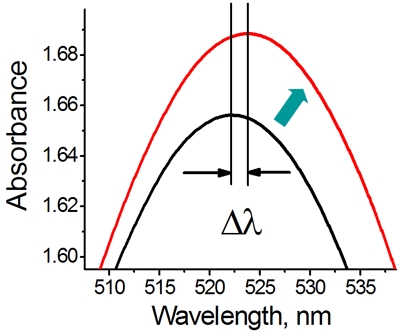LSPR biosensing
Among the number of LSPR applications, utilization of this optical effect for biosensing and medical diagnostics is one of the most researched. Such interest is based on the advantages provided by this technique, which include real-time label-free detection of biomolecules, the possibility to carry out affinity investigations by using modified nanoparticles, miniaturization possibilities and moderate technical requirements, namely, an inexpensive UV-Vis spectrophotometer. LSPR biomolecular sensing makes use of the sensitivity of nanoparticle’s LSPR spectrum to emergent biomolecular covers on its surface (Fig. 1, 2).

The sensing principle of the LSPR method is based on the fact that the light absorption, scattering and extinction spectra of noble metal nanoparticles exhibit a high sensitivity to the change of ambient dielectric permittivity caused by the adsorption of biomolecules (Fig. 2). The LSPR spectrum shape is dependent on the nanoparticle shape, size, interparticle distance, dielectric properties of the nanoparticle material, and, most importantly, on the dielectric properties of the surrounding medium. This last feature serves as a basis for the development of biological and chemical LSPR sensors.
